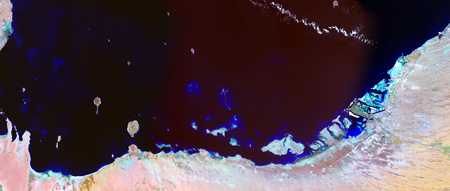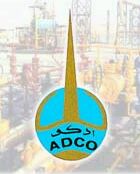| ...... |
 |
 |
The
Abu Dhabi Islands Archaeological Survey (ADIAS) was established in 1992
on the instruction of the late President His Highness Sheikh Zayed bin
Sultan Al Nahyan, under the patronage of His Highness General Sheikh
Mohammed bin Zayed Al Nahyan, now Deputy Supreme Commander of the UAE
Armed Forces and Crown Prince of Abu Dhabi. ADIAS was charged with surveying
for, recording and, where appropriate, excavating archaeological sites
on the coast and islands of Abu Dhabi. In the years that have followed,
ADIAS has identified over a thousand sites or groups of sites on the
coast and islands of Abu Dhabi, as well as deep in the deserts of the
interior. Among the sites are several of international importance, including
the oldest-known settlement in the Emirates, on Marawah island,and major
sites in the south-eastern deserts of Abu Dhabi, near Umm az-Zamul,
these all being of Late Stone Age date, and the only pre-Islamic Christian
monastery yet identified in south-eastern Arabia, on the island of Sir
Bani Yas. ADIAS teams have also identified numerous sites of palaeontological
importance, with vertebrate fossils from the Late Miocene period, around
6-8 million years ago.
ADIAS was funded until mid-2006 partly by the Private Department of
the President. Corporate support for ADIAS has been received from a
variety of sponsors, including Abu Dhabi
National Oil Company (ADNOC), Abu
Dhabi Company for Onshore Oil Operations (ADCO), Abu Dhabi Petroleum Ports Operating Company
(ADPPOC), Emirates Airlines,
Hilalco, Takreer
and a variety of multinational corporations, including BP and ICL (now known as Fujitsu).
ADIAS also undertakes consultancy work in the Emirate of Abu Dhabi, and, through associates, in the Northern Emirates, to identify archaeological and palaeontological sites as part of Environmental Baseline Studies and Environmental Impact Assessments. Summary details of sites in the Emirate of Abu Dhabi are held on a database housed for ADIAS by the Environmental Agency - Abu Dhabi, EAD, as part of its Abu Dhabi Environmental Database, EDB, project.
The methodology adopted by ADIAS is three-fold.
The first is the undertaking of field surveys, to locate, identify and
record the presence of sites. In some cases, the selective collection
of archaeological artefacts, such as pottery, and of environmental remains,
such as mollusc shells, is undertaken. While, in principle, ADIAS has
always recognised the desirability of avoiding the removal of data in
a non-systematic manner, in practice, the rapid development of much
of the coastal zone and islands, combined with the fragility of many
of the archaeological features recognised, makes it necessary to recover
at least an apparently representative sample of the available data when
a site was first identified. The second type of work, undertaken at
selected sites, involves detailed topographical mapping, drawing and
recording. In a small minority of sites, viewed from the surface collections
as being of most potential interest, systematic excavation has been
undertaken in the past.
The results of the fieldwork by ADIAS, combined with the results
of earlier work, particularly on the island of Umm al-Nar, has shown
that archaeological sites of relevance for the cultural heritage of
the people of Abu Dhabi can be found on almost every one of the islands
that have been examined as well as on parts of the coastline, generally
those areas of raised elevation, particularly on former shorelines.
On 14th October 2005, President HH Sheikh Khalifa bin Zayed Al Nahyan,
acting as Ruler of Abu Dhabi, issued a law to establish the Abu Dhabi
Authority for Culture and Heritage (ADACH), to re-structure the
way in which archaeology and palaeontology are handled in the Emirate
of Abu Dhabi.
According
to the terms of the new Law, the Authority: "will oversee intellectual
and artistic activities in the Emirate of Abu Dhabi and will also be
responsible for maintaining, protecting, managing and promoting the
cultural heritage of the Emirate through the following means:
- the evolving
of cultural policies, plans and programmes and ensuring that such policies
are implemented.
- undertaking
projects designed to develop, promote and protect the cultural heritage
of the Emirate and to make appropriate recommendations to the relevant
authorities.
- organising
and developing activities dealing with the heritage of the country as
well as organising conferences, cultural shows, plastic arts exhibitions
and other activities related to the activities of the National Library.
- organising
study programmes and seminars and other intellectual, scientific and
professional meetings in addition to the publication of research and
studies in the field of culture and heritage.
- conserving
historical, archaeological and heritage sites and buildings and preparing
an inventory of cultural property and artefacts.
- carrying
out of archaeological excavations, conserving archaeological artefacts
and relics and issuing licences for excavations.
- supervising
the work and activities of archaeological excavation teams and establishing
a department to manage, develop and supervise museums and other buildings
where cultural artefacts are housed.
- recommending
laws and regulations to protect, promote and preserve cultural heritage.
- providing
support for training and educational activities.
- developing
human and cultural resources in the fields of documentation, management,
archiving and preservation of cultural heritage.
- outlining
general plans for the activities of museums, in addition to planning
for exhibitions on heritage.
- checking
for violations of and damage to the cultural heritage and antiquities
of the emirate and taking the necessary legal action in association
with the relevant authorities.
- providing
support and assistance to bodies working in the field of the preservation,
management and promotion of cultural heritage.
- exercising
control over heritage and cultural property, whether public or private.
- managing
the National Library in such a way as to enrich and promote intellectual,
artistic and scientific activities in Abu Dhabi through the provision
of references, journals and periodicals in Arabic and other languages
in various fields of knowledge.
- recording
national history through the collection of documents, the registering
of the heritage of the emirate and through the publication of works
in this field.
The Authority has a Board of Directors, consisting of
a Chairman, a Deputy Chairman and seven or more other members, whose
powers will be specified in a decision to be taken by the Abu Dhabi
Executive Council.
The following organisations
have been merged into the new Authority: the Cultural
Foundation, the National
Library, the Department of Antiquities
and Tourism in Abu Dhabi's Eastern Region and the Cultural Heritage
section of the Abu Dhabi Tourism
Authority.
home
|








